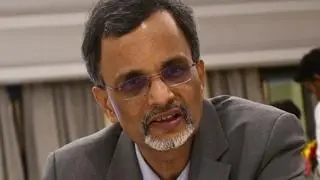Though growth of 3.6 per cent in Index of Industrial Production for September was disappointing compared to higher single digit of 6.3 per cent witnessed in August, Madan Sabnavis, chief economist of Credit Analysis and Research, expects the same to be sustainable and be in the range of 4-5 per cent for FY16.
He is satisfied with the government’s job so far despite defeat in Bihar elections and is confident that corporate performance are not seen atleast deteriorating from December quarter.
What is your view on IIP growth going ahead?
The cumulative IIP growth for the first six months of this fiscal has been 4.4 per cent. This I think is reasonable given the base of 3 per cent in the same period last year and also for full year of FY15. More importantly, capital goods and consumer durable goods have shown positive movement upwards. I won’t say it is a great revival but definitely it is a major improvement over last year. This also gives indication that things are happening on the industrial front, which probably won’t get fully reflected in the current financial year. But hopefully next financial year we would see a more complete revival cycle taking place at a higher range and I see this being driven by both consumer and capital goods.
Is growth in consumer durables and capital goods sustainable?
I am not too confident whether growth in consumer durables is sustainable as it depends also on how the rural incomes and spending behave, but the rise seen in capital goods is definitely sustainable as the government has been talking of spending a lot especially on roads and railways. So if those contracts materialise, private sector would see greater demand for machinery. I am focusing more on the government as the engine for this year as private capex will take time to pick up given the current capacity utilization of 70 per cent as per data by Reserve Bank of India. Normally until the capacity utilisation reaches 80-85 per cent, private players don’t start investments in fresh capex.
Given the IIP growth in the first six months, do you feel confident about India’s improving growth prospects?
Given the fact that for the last three years, we have seen very low industrial growth rate in the region of 2-3 per cent and lot of policy initiatives have been taken by the government, I am satisfied about what is happening presently though arguably one would have been happy with a better growth rate. But there is may still be less to cheer about as it is not a major turnaround. India has been used to growth rate in the region of 8-10 per cent (going by the new methodology juxtaposed on the earlier numbers). Today it is in the region of 4-5 per cent, which is half of what the potential is.
Are you happy with the government’s pace of work?
If it was so easy to turn around an economy, Japan would not have been in recession for 25 years. Even after 8 years, the US is not seeing any major signs of turnaround. Euro economy has also been down and in the dumps for a long time. The government there has tried everything for the last five years but nothing has worked. Given our budget of Rs 17 lakh crore, expectations to turnaround an economy are unreasonable. I think the NDA government has done spectacularly well in terms of doing what could be done. It is working on the administrative side, policies to bring back private sector investment, bankruptcy code, revival of state electricity boards and foreign direct investment. Government spending definitely seems to be on target. The impact of government action can be seen in terms of how India has improved its ranking over the last one year on many parameters like overall doing business environment, World Bank ranking, World Economic Forum and Global competitive index. These are definitely attributable singularly to government. Expecting government to do more miracles is not possible at this stage given the fiscal constraints. Now it is for the private sector to take up the initiative but it will take time until the problem of demand is sorted out. Consumers are not spending because they do not have the purchasing power. Government is not spending because they have 3.9 per cent fiscal deficit target. And industry is not investing given surplus capacity. This evidently has to change to bring about a turnaround.
How far will reforms on land and GST front will help in GDP growth?
I think that we are probably overstating the role of land reforms and GST in terms of saying that they are miracles for us. Even if we have land reforms passed, we still won’t see a major turnaround as there are many legacy issues or -earlier stalled projects which will need to be solved or revived first. Further, in my opinion, mere implementing GST will not bring a huge uptick to GDP as according to me GST is an efficiency enhancer. In short, there are no easy solutions to the economy and historically, economies take time to recover. It is always a U shaped recovery and not V shaped.
Do you also see India Inc’s financial performance bottoming out from December quarter like many market experts?
I don’t rule it out that December quarter we will see bottoming out of the corporate performance. Even if September quarter witnessed a decline in sales for the fourth consecutive quarter, the’ negative numbers’ have improved. I am confident that things are not going to deteriorate from here in terms of pace of recovery. We could probably go in for positive growth from next quarter onwards.
Do you think India’s monetary policy will get affected by US rate hike?
Our monetary policy is driven more by domestic factors with RBI formally targeting consumer price based inflation. A US rate hike will affect more in terms of foreign institutional investment inflows, exchange rates, and balance of payments. Unless these gets affected heavily, I don’t think RBI is worried too much. Besides, today to derive an export edge, a little more aggressive depreciation could be welcome.
The RBI policy meet is before the US Fed meet in December. What do you think it will do?
I think the RBI will opt for a status quo in the December policy since inflation has gone up and US Fed is definitely going to start increase interest rates which will impact currency and foreign flows to India. But by March there could be a rate cut of 25 bps in a bid to spur growth.
Which sectors pose as serious threat to bank’s nonperforming loans?
While infrastructure, steel, textiles, mining and aviation are known risks to bank’s NPA problem for very long, priority sector lending can throw biggest surprise in terms of NPA. If you see balance sheets of some of the large public sector banks, agricultural loans have seen highest amount of NPAs.Admittedly, this is beyond the purview of the banks given that when monsoons fail, there would be a tendency for the delinquency rates to increase.








Comments
Comments have to be in English, and in full sentences. They cannot be abusive or personal. Please abide by our community guidelines for posting your comments.
We have migrated to a new commenting platform. If you are already a registered user of TheHindu Businessline and logged in, you may continue to engage with our articles. If you do not have an account please register and login to post comments. Users can access their older comments by logging into their accounts on Vuukle.